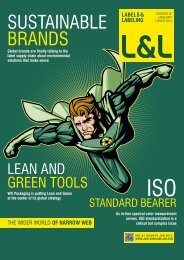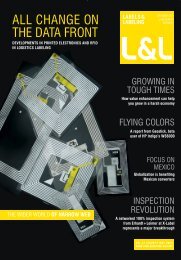SELL
Download - Labels & Labeling
Download - Labels & Labeling
- No tags were found...
You also want an ePaper? Increase the reach of your titles
YUMPU automatically turns print PDFs into web optimized ePapers that Google loves.
LABELS&LABELING |67<br />
JINHAI Paper Machine<br />
China invests to meet<br />
booming paper demand<br />
CHINA’S enormous hunger for paper, including packaging and label papers, is driving the country to raise<br />
domestic production. Danielle Jerschefske reports<br />
Paper was invented in China during the<br />
Han Dynasty in 105 AD and in 740 AD the<br />
first newspaper was printed there. Through<br />
trade and war the skill made its way<br />
through the Middle East and into Europe<br />
where Johann Guttenberg invented the<br />
printing press in 1453. Now the material is<br />
everywhere.<br />
Current global consumption of paper<br />
stands at 345 million tons, up from 300<br />
million tons at the end of last year. In<br />
China, a country that is experiencing<br />
rapid growth in all areas – the label sector<br />
alone is growing at eight to 10 percent per<br />
annum – it is difficult to meet the demand<br />
for paper from domestic resources alone.<br />
The nation’s domestic consumption of<br />
paper has risen 121 percent since 2000<br />
and national demand probably surpassed<br />
100 million tons in 2010. With the economy<br />
growing at 10 percent per year, it has been<br />
hard for the domestic Chinese forestry<br />
industry to keep up with demand, and<br />
pulp imports increased by over 43 percent<br />
between 2008-2009. By 2015 the country’s<br />
timber consumption is expected to reach<br />
340 million square meters, over twice<br />
China’s annual production.<br />
The Chinese government reacted with<br />
its Forest Industry Development Plan<br />
(2010-2012), which aims to increase<br />
domestic production of wood fiber by 12<br />
percent each year, supporting, through<br />
subsidies and favorable state loans, the<br />
development of integrated plantation-pulp-<br />
paper systems. One of the companies<br />
which has benefited is Asia Pulp and<br />
Paper (APP) China.<br />
APP is a subsidiary of the Sinar Mas<br />
Group conglomerate headquartered<br />
in Singapore, founded in Indonesia in<br />
1972 by one of Indonesia’s wealthiest<br />
men, Eka Tjipta Widjaja. In 1978 it was<br />
producing a mere 12,000 tons of paper<br />
a year.<br />
The company first entered the Chinese<br />
market in 1992 and now manages 20<br />
pulp and paper mills as subsidiaries or<br />
joint ventures. The company employs<br />
over 38,900 people and has total assets<br />
of RMB 96.3 billion (14.8 billion dollars)<br />
and annual sales over RMB 37.9 billion<br />
(5.8 billion dollars) in 2010. APP China’s<br />
vision is to become the world’s premier<br />
fully integrated ‘green-cycle forestry’,<br />
pulp and paper company.<br />
APP China Forestry (ACF) was<br />
established in 1995 on the island<br />
of Hainan, a vacation destination<br />
considered to be the Hawaii of China. It<br />
manages more than 303,000 hectares<br />
(one hectare = 2.3 acres) of plantations<br />
in eight Chinese provinces all certified<br />
to ISO 14001 standards. But these<br />
plantations are not always laid out in the<br />
fashion that one would imagine. Rather<br />
than planting groomed rows and rows<br />
of harvestable trees, the ACF plantations<br />
are often scattered throughout the<br />
landscape, integrated into the local<br />
communities amongst local farming land<br />
suitable for various crops like pineapple<br />
and peppers.<br />
GEP engineer at paper machine<br />
JANUARY 2012 | L&L
















